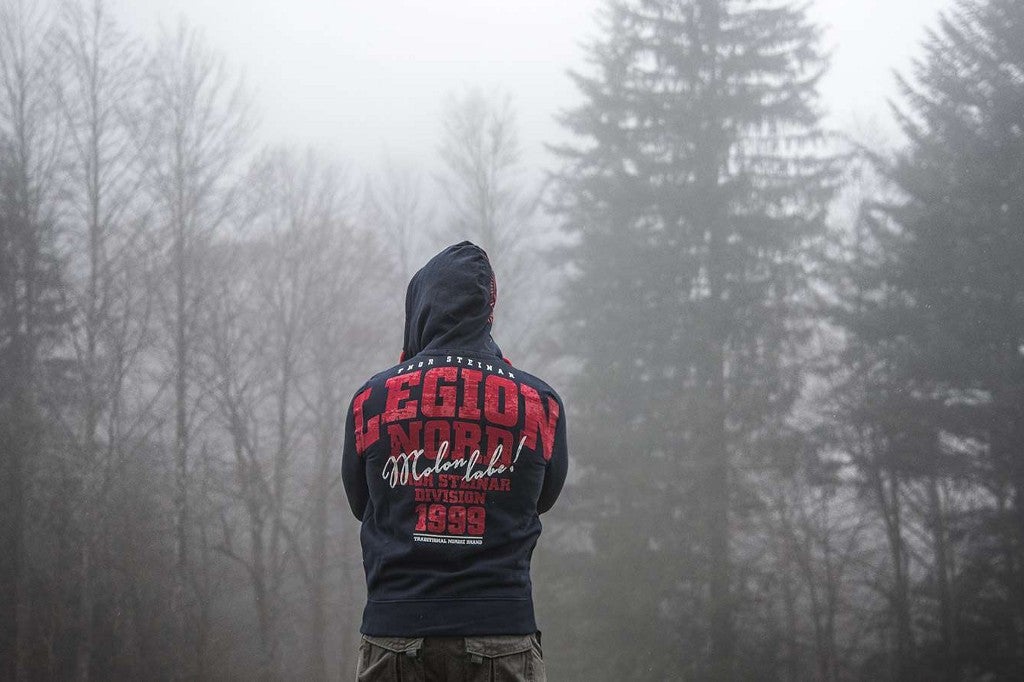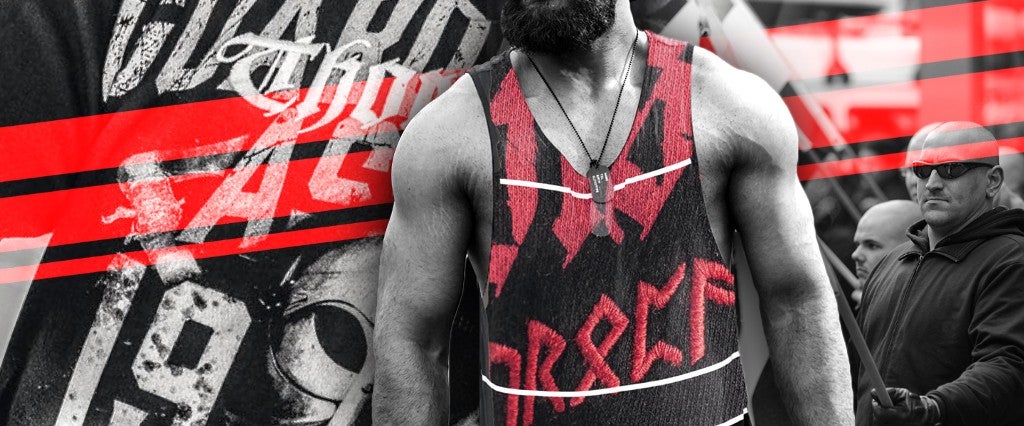Thor Steinar’s shirts look like Ed Hardy meets Big 5, but with a big dose of white supremacy
At a cursory glance, the T-shirt looks like an ad for Sea World. An orca, triumphantly jutting out of the sea, splashes water above the words “Antarktis-Expedition.” It takes just a second longer to notice the bold text hovering above the orca: “Save the White Continent.”
The shirt was created by the German label Thor Steinar, one of a few clothing brands that cater to neo-Nazis. Like Ansgar Aryan and Erik and Sons, Thor Steinar uses coded references to obscure events in Nazi history, veiled threats and playful imagery to flout German hate-speech laws, which forbid explicit references to the Third Reich.
I saw my first Thor Steinar outfit while living in Berlin. Before I knew they were associated with Nazis, I thought they were just ugly: the camo prints, the skulls, the Old German typeface. Apart from the logo — an oddly menacing arrow jutting out of a zig-zag — the clothes didn’t strike me as particularly threatening. Hitler’s SS wore sleek outfits designed by Hugo Boss; these shirts looked somewhat childish in comparison, like if Big 5 Sporting Goods’ design team had merged with Ed Hardy’s.
Scrolling through the Thor Steinar website is like leafing through a vaguely sinister Abercrombie & Fitch catalogue. The male models are muscular, rugged, tattooed. They’re pictured on the beach, leaning against German cars or peering with suspicion over their shoulders. Unlike most fashion ads, the resounding message seems to be, “I’m a scary motherfucker.”

That message is resonating across Europe, where Thor Steinar now operates 47 stores in six countries. A new store just opened in Hamburg in March, to the consternation of many locals. And the brand’s largest area of growth seems to be in Eastern Europe and Russia, where 31 of the stores are currently located and where, according to some reports, the locals don’t even know that they’re wearing Nazi clothes — a scenario that brings to mind this classic Curb Your Enthusiasm bit:
Cynthia Miller-Idriss, a researcher who studies how German youth have embraced far-right fashion, believes the clothing doesn’t just reflect far-right identity but helps shape it. She’s written a book about the topic called The Extreme Gone Mainstream, which comes out in February. “Some people say, ‘Aren’t you overreacting? [The teens] tend to grow out of this,’” she says. “I don’t want to be alarmist, but I do think these kinds of clothing have the potential to radicalize, recruit, socialize and mobilize. They’re not just window dressing.”
Unlike a tattoo, a sweatshirt is an easily removable vessel for expressing your views: It allows you to “try on” a Nazi identity. “It’s performative,” Miller-Idriss says. “It’s also a softer step than shaving your head. You can change your clothing; you can zip up your jacket. You’re using your body, but in an experimental way that can be an easier entry point into the scene than more elaborate or serious body modifications.”
Miller-Idriss first came across far right fashion while researching identity and nationalism in Germany for a book she was writing called Blood and Culture. It was the early 1990s, not long after unification, and she was stationed at a trade school for students in the construction industry. (She says German teens in scaffolding school are particularly likely to identify with the far right, though no one seems to know why.) At the time, many administrators were grappling with extremism on campus.

“It was all totally fascinating,” she says. When she returned to the country in 2009, the Thor Steinar brand had transformed the scene. “When Thor Steinar emerged, the entire aesthetic changed. These brands allowed for people to blend in a little bit more, or present themselves as more alternative.” (There’s even a Nazi martial arts brand, for example.)
To understand the appeal of brands like Thor Steinar, Miller-Idriss pored over 2,924 images of neo-Nazi stickers, buttons, patches, banners, flags and clothing. Some of the symbols toe the line between forbidden and permitted imagery, like the brand’s own logo, which bears a striking resemblance to an SS uniform. The logo was banned by a German court in 2004, but the company won a reversal in 2008. “When it comes to the law, it’s like a game of cat-and-mouse with these companies,” Idriss-Miller says.
Some told her they saw the brands as cool and transgressive precisely because they were banned. Others wore them to stoke fear. “If someone sees three people standing there dressed like [a right-wing extremist], one normally doesn’t get closer,” an interviewee told her. Yet more bought them because everyone else in their neighborhood did, too. “Surely there are also totally normal people [who wear it],” a student explained to her. “Just because someone wears a Thor Steinar sweater and has a shaved head doesn’t mean he’s a Nazi,” added another.
The specific messages embedded in the clothing, however, was often lost on the 50 students Miller-Idriss interviewed. For example, a faux-cheerful shirt that read “Good Morning Angola,” a reference to an early 20th-century proposal to resettle Jewish refugees in the African country, was understood by just 4 percent of her subjects. A summery, touristic shirt that read “Expedition Tibet,” referencing the SS expeditions to research the roots of the Germanic race in Asia, was understood by 8 percent.
Before the rise of brands like Thor Steinar, far-right groups would appropriate mainstream labels like Alpha Industries, Fred Perry, Pitbull and New Balance, all of which unintentionally contained symbols that seemed to echo Nazi iconography, however weakly. The “N” in New Balance could stand for “Nazi,” while the name Lionsdale, when partially obscured by a jacket, could spell out NSDA, most of the acronym for the NSDAP (or Nationalsozialistische Deutsche Arbeiterpartei, aka Nazi.)
Thor Steinar, however, took the concept much further, introducing new, hyper-masculine tropes to the coded Nazi references. While the brand conveys racist ideologies, it does so under the guise of fostering male camaraderie and community. “It valorizes traits like loyalty, solidarity, courage and heroism,” Idriss-Miller writes. The iconography is filled with soldiers, warriors and sailors. Norway, a placeholder for all things Aryan, is often granted a starring role.
Marrying capitalism with Nazism isn’t a new idea. In the 1930s, companies produced Nazi toy soldiers, clothing and plates. You could buy pocket watches, busts of Hitler, “even light bulbs with swastikas,” according to Miller-Idriss. Hitler railed against these trinkets, claiming they devalued Nazi ideology. “Out with National Kitsch!” roared a 1933 headline in the Cologne newspaper, Der Feuerreiter Köln.
Today, it’s rather disturbing to see how easily a Nazi brand has colonized Europe and Russia, though there has been some pushback. After Thor Steinar opened a store in Chemnitz, Germany, called Breivik (an homage to far-right terrorist Anders Breivik), thousands of protesters took to the streets and the store was forced to change its name.
To Miller-Idriss, though, those protests are just the start — especially here in the U.S. After incidents like Charlottesville, she’s more convinced than ever that the kind of hateful iconography Thor Steinar either outright borrows or hints at should be banned, going beyond even the German laws regarding their display and discussion.
“Having watched this evolve in the States, I can see why banning speech or iconography that’s false or dangerous is important — even if it can backfire,” she explains. “I believe that it can backfire and make some situations worse, but I also believe that there are situations when we should do it anyway.”
